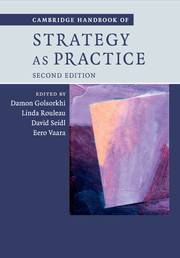Book contents
- Frontmatter
- Contents
- List of figures
- List of tables
- List of boxes
- List of contributors
- Preface to the Second Edition
- Introduction: what is strategy as practice?
- Part I Ontological and Epistemological Questions
- Part II Theoretical Resources: Social Theory
- Part III Theoretical Resources: Organization and Management Theories
- Part IV Methodological Resources
- 24 Using ethnography in strategy-as-practice research
- 25 Researching strategists and their identity in practice: building ‘close-with’ relationships
- 26 Studying strategizing through biographical methods: narratives of practices and life trajectories of practitioners
- 27 Researching everyday practice: the ethnomethodological contribution
- 28 Critical discourse analysis as methodology in strategy-as-practice research
- 29 Studying strategy as practice through historical methods
- 30 Quantitative methods in strategy-as-practice research
- Part V Substantive Topic Areas
- Index
- References
25 - Researching strategists and their identity in practice: building ‘close-with’ relationships
from Part IV - Methodological Resources
Published online by Cambridge University Press: 05 October 2015
- Frontmatter
- Contents
- List of figures
- List of tables
- List of boxes
- List of contributors
- Preface to the Second Edition
- Introduction: what is strategy as practice?
- Part I Ontological and Epistemological Questions
- Part II Theoretical Resources: Social Theory
- Part III Theoretical Resources: Organization and Management Theories
- Part IV Methodological Resources
- 24 Using ethnography in strategy-as-practice research
- 25 Researching strategists and their identity in practice: building ‘close-with’ relationships
- 26 Studying strategizing through biographical methods: narratives of practices and life trajectories of practitioners
- 27 Researching everyday practice: the ethnomethodological contribution
- 28 Critical discourse analysis as methodology in strategy-as-practice research
- 29 Studying strategy as practice through historical methods
- 30 Quantitative methods in strategy-as-practice research
- Part V Substantive Topic Areas
- Index
- References
Summary
Introduction
The strategy-as-practice field has, from its inception, had an interest in innovative research methodology (Balogun, Huff and Johnson 2003). This interest was driven principally by the recognition that empirical studies of strategy as practice faced contradictory pressures to, on the one hand, gain the necessary depth of data yet, on the other, possess sufficient breadth to enable theorizing on the basis of ‘praxis, practices and practitioners’ (Whittington 2006a). The challenge is to collect data that drill deep enough to meet the micro-challenge of the SAP agenda in terms of detail on strategic activity (Johnson, Melin and Whittington 2003) but also to enable a sufficient understanding of the linkages between that detail of action and ‘higher’-level outcomes in order to address the ‘So what?’ question and theorize beyond the specifics of the particular context under study (Balogun, Jarzabkowski and Seidl 2007; Jarzabkowski, Balogun and Seidl 2007; Whittington 2007).
This chapter contributes to the developing methodological dialogue (Balogun, Huff and Johnson 2003; Denis, Langley and Rouleau 2007; Langley 2007; Hodgkinson and Clarke 2007; Vaara and Whittington 2012) in the SAP field. To do so, it builds on the argument advanced by Balogun, Huff and Johnson (2003: 197) that strategy-as-practice ‘research can not advance significantly without reconceptualising frequently taken-for-granted assumptions about the way to do research and the way we engage organizational participants’. Whereas existing reflections on the methodological challenges for strategy as practice are typically inclusive, however (that is, addressing challenges that pertain to praxis, practices and practitioners), this chapter adopts a more exclusive approach. While maintaining the position that strategizing occurs at the nexus of praxis, practices and practitioner activity and to study one aspect means in some way to study all, it privileges study of the practitioner. Empirical SAP research has tended to focus on praxis and practices, or practitioners and the practices they draw on, with much less research focusing on practitioners and their praxis. Existing work demonstrates the important, yet often overlooked, impact of strategists’ identities on their strategizing activity (for example, Balogun et al. 2014; Beech and Johnson 2005; Johnson, Balogun and Beech 2006; Rouleau 2003; Suominen and Mantere 2010; Fenton and Langley 2011): understanding how strategists shape strategizing activity through who they are.
- Type
- Chapter
- Information
- Cambridge Handbook of Strategy as Practice , pp. 447 - 461Publisher: Cambridge University PressPrint publication year: 2015
References
- 2
- Cited by



